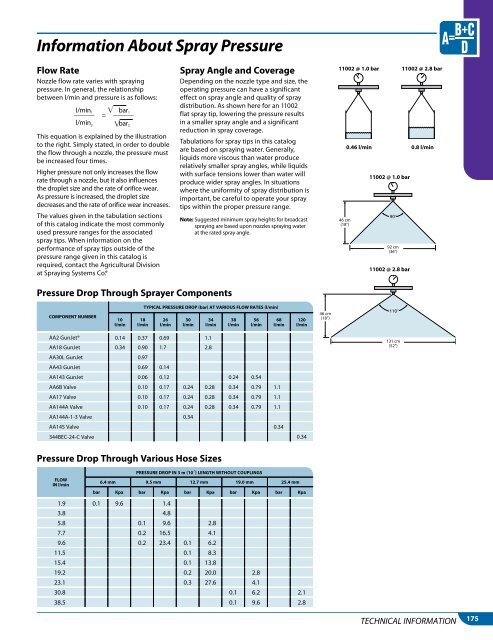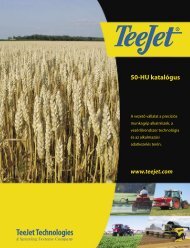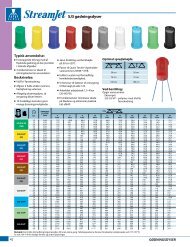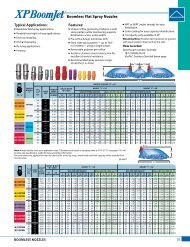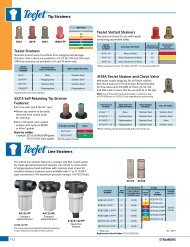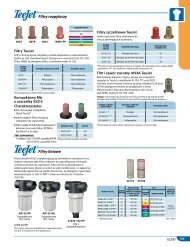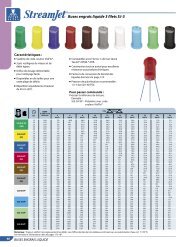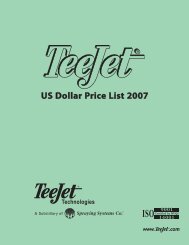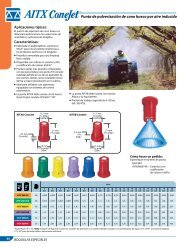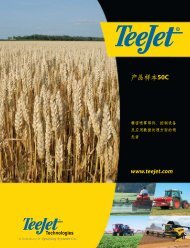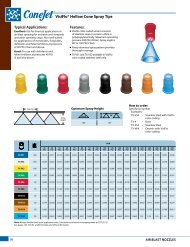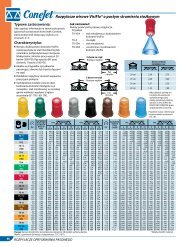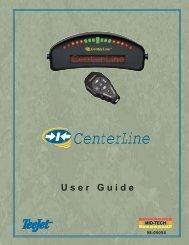Create successful ePaper yourself
Turn your PDF publications into a flip-book with our unique Google optimized e-Paper software.
Information About Spray Pressure<br />
Flow Rate<br />
Nozzle flow rate varies with spraying<br />
pressure. In general, the relationship<br />
between l/min and pressure is as follows:<br />
______ l/min 1<br />
E bar 1<br />
= ______<br />
l/min 2 Ebar 2<br />
This equation is explained by the illus tration<br />
to the right. Simply stated, in order to double<br />
the flow through a nozzle, the pressure must<br />
be increased four times.<br />
Higher pressure not only increases the flow<br />
rate through a nozzle, but it also influences<br />
the droplet size and the rate of orifice wear.<br />
As pressure is increased, the droplet size<br />
decreases and the rate of orifice wear increases.<br />
The values given in the tabulation sections<br />
of this catalog indicate the most commonly<br />
used pressure ranges for the associated<br />
spray tips. When information on the<br />
performance of spray tips outside of the<br />
pressure range given in this catalog is<br />
required, contact the Agricultural Division<br />
at Spraying Systems Co.®<br />
Spray Angle and Coverage<br />
Depending on the nozzle type and size, the<br />
operating pressure can have a significant<br />
effect on spray angle and quality of spray<br />
distribution. As shown here for an 11002<br />
flat spray tip, lowering the pressure results<br />
in a smaller spray angle and a significant<br />
reduction in spray coverage.<br />
Tabulations for spray tips in this catalog<br />
are based on spraying water. Generally,<br />
liquids more viscous than water produce<br />
relatively smaller spray angles, while liquids<br />
with surface tensions lower than water will<br />
produce wider spray angles. In situations<br />
where the uniformity of spray distribution is<br />
important, be careful to operate your spray<br />
tips within the proper pressure range.<br />
Note: Suggested minimum spray heights for broadcast<br />
spraying are based upon nozzles spraying water<br />
at the rated spray angle.<br />
11002 @ 1.0 bar<br />
46 cm<br />
(189)<br />
0.46 l/min<br />
11002 @ 1.0 bar<br />
90°<br />
92 cm<br />
(369)<br />
11002 @ 2.8 bar<br />
11002 @ 2.8 bar<br />
0.8 l/min<br />
Pressure Drop Through Sprayer Components<br />
Component Number<br />
10<br />
l/min<br />
18<br />
l/min<br />
Typical Pressure Drop (bar) at Various Flow Rates (l/min)<br />
26<br />
l/min<br />
30<br />
l/min<br />
34<br />
l/min<br />
38<br />
l/min<br />
56<br />
l/min<br />
68<br />
l/min<br />
120<br />
l/min<br />
46 cm<br />
(189)<br />
110°<br />
AA2 GunJet®<br />
AA18 GunJet<br />
0.14 0.37 0.69 1.1<br />
0.34 0.90 1.7 2.8<br />
131 cm<br />
(529)<br />
AA30L GunJet<br />
0.97<br />
AA43 GunJet<br />
0.69 0.14<br />
AA143 GunJet<br />
0.06 0.12 0.24 0.54<br />
AA6B Valve<br />
0.10 0.17 0.24 0.28 0.34 0.79 1.1<br />
AA17 Valve<br />
0.10 0.17 0.24 0.28 0.34 0.79 1.1<br />
AA144A Valve<br />
0.10 0.17 0.24 0.28 0.34 0.79 1.1<br />
AA144A-1-3 Valve<br />
0.34<br />
AA145 Valve<br />
0.34<br />
344BEC-24-C Valve<br />
0.34<br />
Pressure Drop Through Various Hose Sizes<br />
Flow<br />
in l/min<br />
Pressure Drop in 3 m (108) length without couplings<br />
6.4 mm 9.5 mm 12.7 mm 19.0 mm 25.4 mm<br />
bar Kpa bar Kpa bar Kpa bar Kpa bar Kpa<br />
1.9 0.1 9.6 1.4<br />
3.8 4.8<br />
5.8 0.1 9.6 2.8<br />
7.7 0.2 16.5 4.1<br />
9.6 0.2 23.4 0.1 6.2<br />
11.5 0.1 8.3<br />
15.4 0.1 13.8<br />
19.2 0.2 20.0 2.8<br />
23.1 0.3 27.6 4.1<br />
30.8 0.1 6.2 2.1<br />
38.5 0.1 9.6 2.8<br />
TECHNICAL INFORMATION<br />
175


